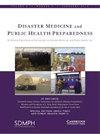Safeguarding Patients with End-Stage Kidney Disease From Climate-driven Extreme Heat and Hurricanes
IF 1.9
4区 医学
Q3 PUBLIC, ENVIRONMENTAL & OCCUPATIONAL HEALTH
引用次数: 0
Abstract
5wPatients with end stage kidney disease (ESKD) who receive in-center hemodialysis are disproportionately vulnerable to extreme weather events, including hurricanes and heat waves, that may disrupt access to healthcare providers, and life-sustaining treatments. This current era of climate-driven compounding disasters is progressively elevating the level of threat to the health and well-being of patients with ESKD. This analysis brings together multi-disciplinary expertise to explore the contours of this increasingly complex risk landscape. Despite the challenges, important advances have been made for safeguarding this medically high-risk patient population. Hemodialysis services providers have devised innovative systems for preparing their patients and sustaining, or rapidly reestablishing, hemodialysis services in the aftermath of a disaster, and maintaining open lines of communication with their caseloads of ESKD patients throughout all phases of the event. A description of lessons learned along the path towards improved patient support in disasters, is provided. The article concludes with a detailed case example, describing dialysis providers’ effective response throughout Hurricane Ian’s passage across the State of Florida in 2022. Based on lessons learned, this analysis outlines strategies for protecting patients with ESKD that may be adapted for future climate-potentiated disaster scenarios.保护终末期肾病患者免受气候导致的极端高温和飓风的影响
5w接受中心内血液透析的终末期肾病(ESKD)患者极易受到极端天气事件(包括飓风和热浪)的影响,这些天气事件可能会中断医疗服务提供者和维持生命的治疗。目前,气候导致的复合型灾害正逐步加剧对 ESKD 患者健康和福祉的威胁。本分析报告汇集了多学科专业知识,以探索这一日益复杂的风险环境的轮廓。尽管挑战重重,但在保护这一医疗高危人群方面已经取得了重要进展。血液透析服务提供商已设计出创新系统,为患者做好准备,在灾难发生后维持或迅速重建血液透析服务,并在事件的各个阶段与 ESKD 患者保持畅通的沟通渠道。文章介绍了在灾难中为患者提供更好支持的经验教训。文章最后提供了一个详细的案例,描述了透析服务提供商在 2022 年飓风伊恩横扫佛罗里达州的整个过程中采取的有效应对措施。在吸取经验教训的基础上,本分析概述了保护 ESKD 患者的策略,这些策略可适用于未来气候加剧的灾害情况。
本文章由计算机程序翻译,如有差异,请以英文原文为准。
求助全文
约1分钟内获得全文
求助全文
来源期刊

Disaster Medicine and Public Health Preparedness
PUBLIC, ENVIRONMENTAL & OCCUPATIONAL HEALTH-
CiteScore
4.40
自引率
7.40%
发文量
258
审稿时长
6-12 weeks
期刊介绍:
Disaster Medicine and Public Health Preparedness is the first comprehensive and authoritative journal emphasizing public health preparedness and disaster response for all health care and public health professionals globally. The journal seeks to translate science into practice and integrate medical and public health perspectives. With the events of September 11, the subsequent anthrax attacks, the tsunami in Indonesia, hurricane Katrina, SARS and the H1N1 Influenza Pandemic, all health care and public health professionals must be prepared to respond to emergency situations. In support of these pressing public health needs, Disaster Medicine and Public Health Preparedness is committed to the medical and public health communities who are the stewards of the health and security of citizens worldwide.
 求助内容:
求助内容: 应助结果提醒方式:
应助结果提醒方式:


